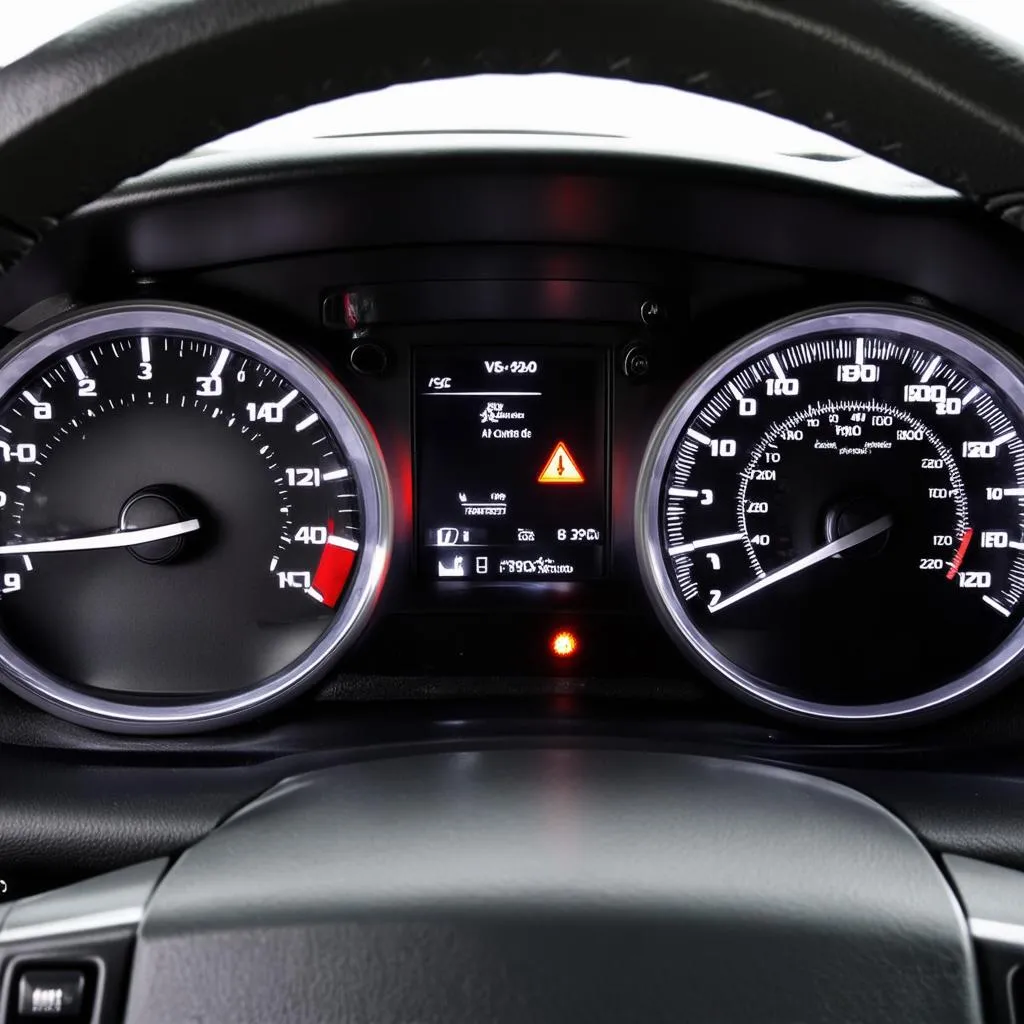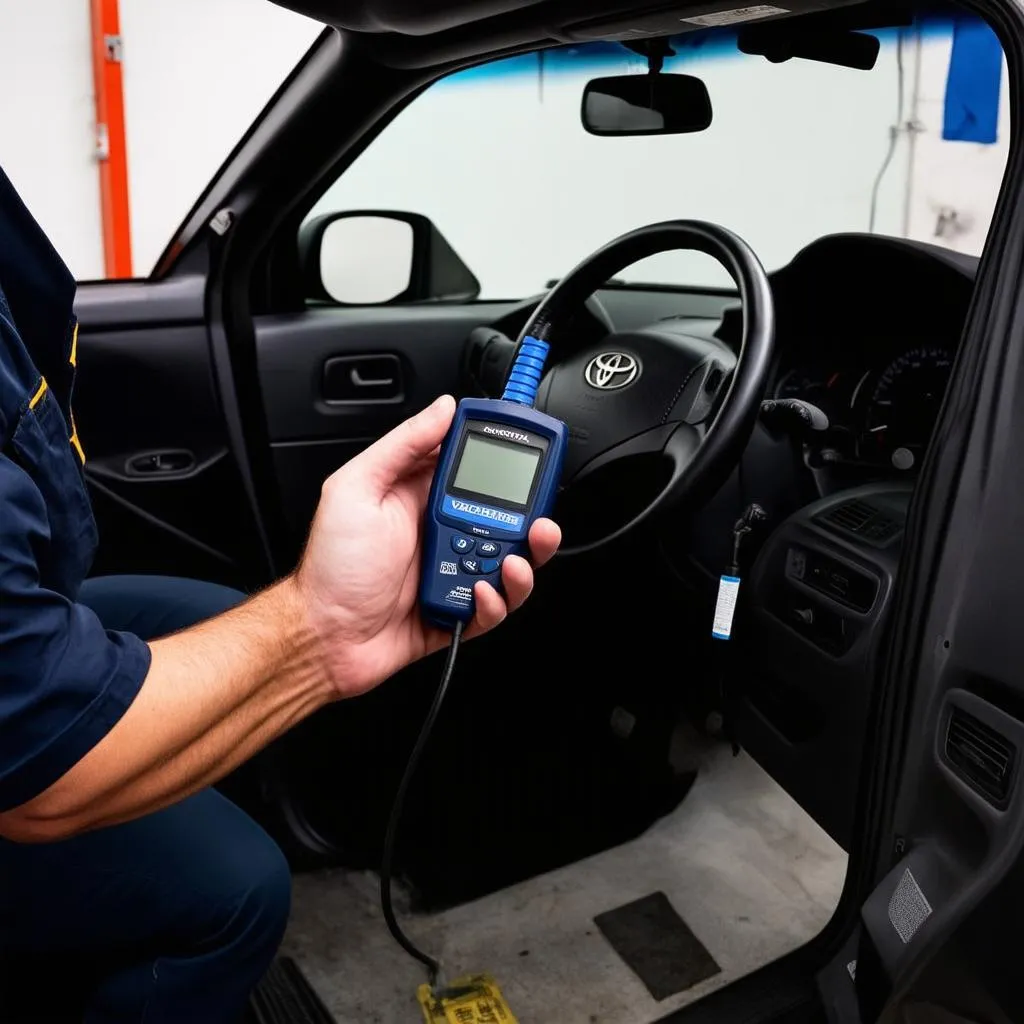Have you ever seen a strange light flashing on your dashboard – the dreaded VSC or TRAC light on your trusty 2004 Toyota RAV4? It can be a little unnerving, right? You’re driving along, minding your own business, and then BAM! These cryptic lights appear, making you wonder if a team of mechanics is needed to decipher their meaning. But before you hit the panic button (or speed dial your mechanic), take a deep breath. We’re about to demystify the world of OBD ports, DLC3 connectors, and how to reset those pesky VSC and TRAC lights on your 2004 RAV4.
Understanding the Language of Your RAV4
Let’s start by understanding what these acronyms actually mean. OBD stands for On-Board Diagnostics, a system built into your car that acts like a health tracker. The OBD port is its communication hub, a small portal usually located under the driver’s side dashboard. It’s like the Rosetta Stone for mechanics, allowing them (and you!) to understand what your car is trying to say.
The DLC3 connector is simply a specific type of OBD port found on many Toyota vehicles, including your 2004 RAV4. Think of it as a dialect spoken by Toyota, making sure your car’s messages are understood.
Now, about those flashing lights. VSC stands for Vehicle Stability Control, a sophisticated safety feature designed to prevent skids and loss of control. TRAC, or Traction Control, works hand-in-hand with VSC to maintain grip on slippery surfaces. When these lights come on, it usually means one or both systems have detected an issue and may be temporarily disabled.
Why Did My VSC and TRAC Lights Turn On?
There are several reasons why your VSC and TRAC lights might decide to put on a show:
- Simple Glitch: Just like our computers, cars can have minor software hiccups. A temporary glitch in the system might trigger the lights.
- Low Battery Voltage: Your RAV4’s electrical systems, including VSC and TRAC, need a healthy battery to function correctly. A low battery can disrupt their operation.
- Faulty Wheel Speed Sensor: These sensors, one on each wheel, help the VSC and TRAC systems monitor your car’s speed and stability. A faulty sensor can send incorrect signals, triggering the warning lights.
- Steering Angle Sensor Issues: This sensor tells the system about your steering wheel position. A problem with this sensor can confuse the VSC and TRAC systems.
 2004 RAV4 Dashboard with VSC and TRAC lights illuminated
2004 RAV4 Dashboard with VSC and TRAC lights illuminated
Resetting Your VSC and TRAC Lights: The DIY Approach
Before you make a beeline for the mechanic, you can try resetting the system yourself. Sometimes, a simple reset is all it takes, especially if it’s a minor glitch. Here’s a step-by-step guide:
-
Locate Your OBD Port: In your 2004 RAV4, the DLC3 OBD port is typically located under the driver’s side dashboard, near the steering column.
-
Visual Inspection: Before plugging anything in, take a quick peek inside the port. Ensure there is no debris, dirt, or foreign objects that could interfere with the connection.
-
Connect Your OBD2 Scanner: You’ll need an OBD2 scanner, a handy tool that connects to your car’s computer system. Many affordable options are available online or at auto parts stores.
-
Turn the Ignition to “On” : Turn the key to the “on” position, but don’t start the engine. This powers up the car’s computer system.
-
Follow the Scanner Instructions: Each scanner is slightly different, so follow the manufacturer’s instructions on how to read and clear codes. Look for codes related to the VSC and TRAC systems.
-
Clear the Codes: Once you’ve identified and noted the codes, most scanners have a “clear codes” function. This action tells the car’s computer to erase the stored error messages.
-
Disconnect the Scanner and Test Drive: After clearing the codes, disconnect the scanner, start your RAV4, and take it for a spin. Pay close attention to see if the VSC and TRAC lights stay off.
 Mechanic connecting an OBD2 scanner to the OBD port of a 2004 Toyota RAV4
Mechanic connecting an OBD2 scanner to the OBD port of a 2004 Toyota RAV4
When a Reset Isn’t Enough: Seeking Professional Help
If the lights reappear after the reset or are accompanied by other symptoms like unusual noises or handling issues, it’s time to call in the experts.
Remember, your car’s safety systems are crucial for your well-being. Don’t ignore persistent warning signs.
Beyond the Technical: A Touch of Feng Shui
In many cultures, cars are seen as more than just machines. They represent freedom, adventure, and personal style. In the world of Feng Shui, an ancient Chinese practice that focuses on harmonizing people with their environment, cars are believed to possess energy.
While a flashing VSC light might not have a direct Feng Shui interpretation, a well-maintained car, free from mechanical issues, can contribute to a smoother, more balanced flow of energy in your life. Think of it this way: when your car is running smoothly, you tend to feel less stressed and more in control, right?
FAQs: Common Questions About RAV4 VSC and TRAC
Q: Can I still drive my RAV4 if the VSC and TRAC lights are on?
A: Yes, you can still drive, but proceed with caution. The systems may not function optimally, potentially affecting handling, especially on slippery roads.
Q: How much does it cost to fix VSC and TRAC issues?
A: Costs vary widely depending on the root cause. A simple sensor replacement might be relatively inexpensive, while a complex electrical issue could be more costly.
Q: Can I reset the VSC and TRAC systems without a scanner?
A: Some older vehicles might have workarounds, but for a 2004 RAV4, using an OBD2 scanner is the most reliable method.
Need More Help?
We’re here to assist you on your automotive journey. For personalized guidance on diagnostic tools and expert advice on your car’s electrical systems, don’t hesitate to reach out to our team of automotive specialists via WhatsApp at +84767531508. We’re available 24/7 to answer your questions and help keep your RAV4 running smoothly.
Keep Exploring:
Interested in learning more about car maintenance, troubleshooting common issues, or the latest in automotive technology? Explore more insightful articles and resources on techcarusa.com. We’re your go-to source for all things automotive!